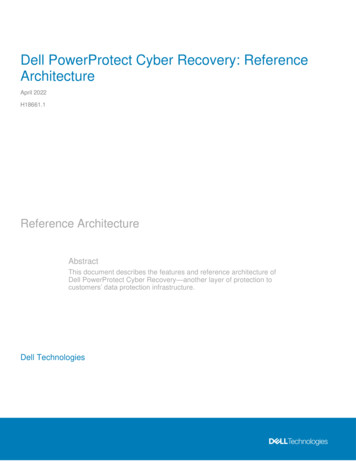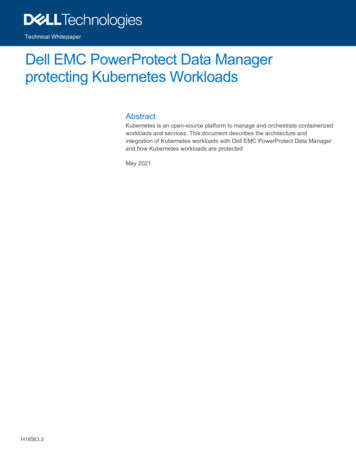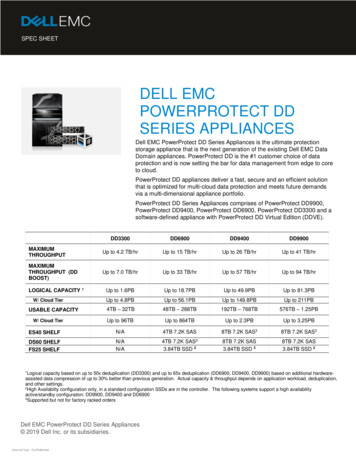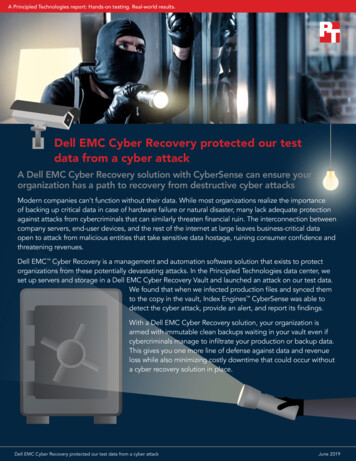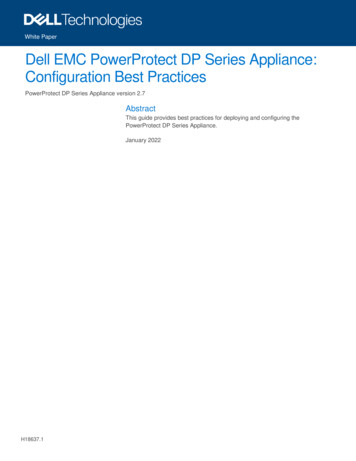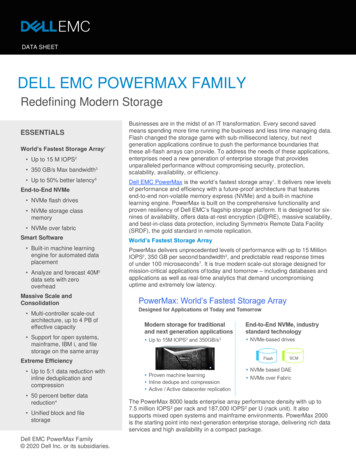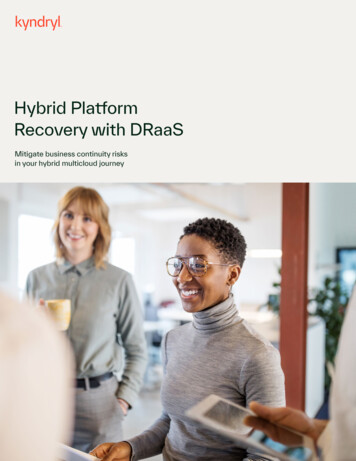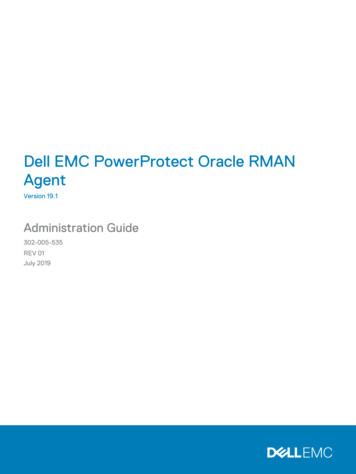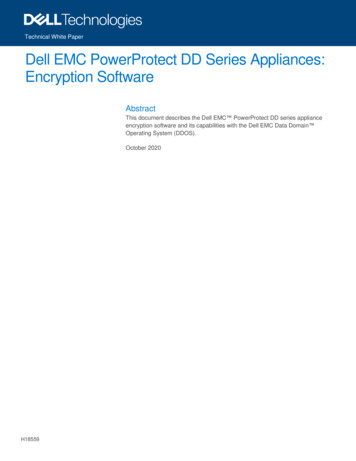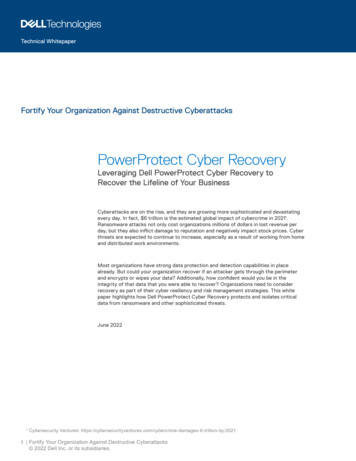
Transcription
Technical WhitepaperFortify Your Organization Against Destructive CyberattacksPowerProtect Cyber RecoveryLeveraging Dell PowerProtect Cyber Recovery toRecover the Lifeline of Your BusinessCyberattacks are on the rise, and they are growing more sophisticated and devastatingevery day. In fact, 6 trillion is the estimated global impact of cybercrime in 20211.Ransomware attacks not only cost organizations millions of dollars in lost revenue perday, but they also inflict damage to reputation and negatively impact stock prices. Cyberthreats are expected to continue to increase, especially as a result of working from homeand distributed work environments.Most organizations have strong data protection and detection capabilities in placealready. But could your organization recover if an attacker gets through the perimeterand encrypts or wipes your data? Additionally, how confident would you be in theintegrity of that data that you were able to recover? Organizations need to considerrecovery as part of their cyber resiliency and risk management strategies. This whitepaper highlights how Dell PowerProtect Cyber Recovery protects and isolates criticaldata from ransomware and other sophisticated threats.June 20221Cybersecurity Ventures: es-6-trillion-by-20211 Fortify Your Organization Against Destructive Cyberattacks 2022 Dell Inc. or its subsidiaries.
June 2022Table of ContentsExecutive Summary 3Major Elements of a Vault 4Dell PowerProtect Cyber Recovery Overview 5Vault Components, Connectivity and Communications 7Dell PowerProtect Cyber Recovery Details 9Analytics In The Vault 11Incident, Response and Recovery Options 13Conclusion 16The information in this publication is provided as is. Dell Inc. makes no representations or warranties of any kind with respect to the informationin this publication, and specifically disclaims implied warranties of merchantability or fitness for a particular purpose.Use, copying, and distribution of any software described in this publication requires an applicable software license.Copyright 2022 Dell Inc. or its subsidiaries. All Rights Reserved. Dell Technologies, Dell and other trademarks are trademarks of Dell Inc. orits subsidiaries. Intel, the Intel logo, the Intel Inside logo and Xeon are trademarks of Intel Corporation in the U.S. and/or other countries. Othertrademarks may be trademarks of their respective owners. Published in the USA.Dell Inc. believes the information in this document is accurate as of its publication date. The information is subject to change without notice.2 Fortify Your Organization Against Destructive Cyberattacks 2022 Dell Inc. or its subsidiaries.
June 2022Executive SummaryAcross industries and among organizations of every size, cyberattacks are on the rise, in fact, Cyber SecurityVentures estimates that every 11 seconds a cyber or ransomware attack occurs.1 Attacks are virtually non-stopand the cost per attack continues to increase, with Accenture estimating that 13 million is the average cost toorganizations resulting from cybercrime.2 As organizations become increasingly aware of the cybersecurityrisks that threaten their mission-critical operations and reputation, IT security has become an essential part ofenterprise digital strategy.Protecting your organization starts with protecting your data — against ransomware and other sophisticatedcyber threats. Yet, cyber threats are becoming more sophisticated, presenting ample opportunity for criminalsusing modern tools and tactics to leverage your critical data for a variety of purposes or destroy and ransom itfor some agenda or benefit. 64% of organizations are concerned that they will experience a disruptive event inthe next twelve months.3With cyber security, it’s not a matter of “if” but “when” you will be faced with such an attack. In the wake of themost sophisticated cyber threats, rather than focusing on preventing ransomware or cyberattacks, organizationsshould focus on protecting critical data or apps that enable you to recover your critical assets with integrity soyou can resume normal business operations with confidence. Yet, many organizations lack confidence in theirdata protection solutions, specifically the Global Data Protection Index reported that 67% of IT decision makersare not very confident that all business-critical data can be recovered in the event of a destructive cyberattack.3The modern threat of cyberattacks and the importance of maintaining the confidentiality, availability andintegrity of data require modern solutions and strategies to protect vital data and systems. Understanding thestakes involved in today’s data-driven world, progressive organizations are adopting cyber resiliency strategiesto identify, protect, detect, respond, and recover from ransomware and other cyberattacks. Achieving a cyberresiliency strategy, incorporates people, process and technology into a holistic framework that protects an entireorganization or entity.Cyber resilience cannot be achieved without a major component. The Vault!Cybersecurity Ventures: y-2021Accenture Insights, Ninth Annual Cost of Cyber crime Study March, rity/cost-cybercrime-study3Gartner “Detect, Protect, Recover: How Modern Backup Applications Can Protect You From Ransomware” report, January 2021:https://www.gartner.com/doc/reprints?id 1-25T81BQP&ct 210416&st sb123 Fortify Your Organization Against Destructive Cyberattacks 2022 Dell Inc. or its subsidiaries.
June 2022Major Elements of a VaultHaving a Cyber Resiliency strategy is a mandate for all organizations and government leaders and can be seenas a competitive advantage in today’s data-driven world. Ensuring cyber resiliency requires multiple layers ofprotection to ensure that critical data is protected and isolated from these attack surfaces so that it can bequickly recovered with confidence following a ransomware attack, to accelerate the restoration of the normalbusiness operations.Ensuring cyber resiliency requires a data vault that incorporates 3 major elements:1.Isolation: The components of the data vault must be physically and logically isolated. “Logical” isolation hassimilarities to an air-gapped network, except that limited connectivity for data updates is permitted on a regularbasis, typically daily.2. Immutability: All data written to the data vault must be “locked” in a manner that electronically prohibitsdeletion or changes until the expiration of the locking period, which is typically a few weeks to a month. Atminimum these requirements should block administrative overrides or virtually based / software definedcomponents that can be destroyed using an administrator’s credentials. While there is not yet a relevantcybersecurity standard for this capability, the requirements of 17 CFR 240.17a-4(f)(ii) and related guidance fromthe US Securities and Exchange Commission can be a useful starting point.3. Intelligence: Data in the vault should be analyzed or interrogated in a manner that ensures it has not beenmanipulated or corrupted. Where the focus of both isolation and immutability is to protect anything copied into thevault, intelligence validates that the data was not corrupted before reaching the vault.Public and private sector organizations have increasingly implemented data vaults, which securely store updatedcopies of their most critical data and applications. If a ransomware or data destruction attack impacts dataand applications in the main production environments, the threat actors still cannot access the contents of thedata vault. Post-attack, as part of the incident response and recovery process, the clean copies of data andapplications stored in the data vault are used to restore the production environment.Dell PowerProtect Cyber Recovery provides the highest levels of protection, integrity and confidentiality foryour most valuable data and critical business systems and are a critical component of a comprehensive CyberResiliency strategy. This assurance that you can quickly recover your most critical data and systems after acyber or other disruptive event is a critical step in resuming normal business operations. A modern and powerfulcyber resilience strategy and Dell Data Protection are key to enabling our customers to increase business agility,accelerate time to market, improve their cloud economics, and reduce business risk.4 Fortify Your Organization Against Destructive Cyberattacks 2022 Dell Inc. or its subsidiaries.
June 2022Dell PowerProtect Cyber Recovery OverviewA robust and comprehensive cyber resiliency strategy should leverage frameworks like the National Instituteof Standards and Technology (NIST Cybersecurity Framework (CSF)), which can help outline an end-to-endcyber- attack defense continuum. In short, Cyber Resiliency is a strategy that incorporates people, process andtechnology into a holistic framework that protects an entire business, organization, or entity. This strategy allowsyou to prepare for and adapt to changing conditions and withstand and recover rapidly from disruptions.Resilience includes the ability to withstand and recover from deliberate attacks, accidents, or naturally occurringthreats or incidents. In our digital world with its reliance on data and real-time access on any device from anylocation it is more and more difficult to be resilient based upon non-technology capabilities.PowerProtect Cyber Recovery is a component of an overall cyber resilience strategy. PowerProtect CyberRecovery distinguishes itself from traditional backup and disaster recovery by providing additional layers ofphysical and logical security at both the solution, system and data/file level. This ensures critical data can bepreserved with integrity, confidentiality and to ensure it is available when needed for recovery. PowerProtectCyber Recovery is focused upon protecting critical data from cyber threats and away from the attack surface —and then recovering that data from an isolated environment when and if necessary.PowerProtect Cyber Recovery focuses on protecting your critical data on-premises or in the cloud andrecovering your businesses following a successful cyberattack or ransomware incident, while leveraging acombination of professional services and technology that provide the following three key elements of a CyberRecovery solution:PowerProtect Cyber Recovery AdvantagesModern protection for critical data and an enabler of Security Transformation5 Fortify Your Organization Against Destructive Cyberattacks 2022 Dell Inc. or its subsidiaries.
June 2022ISOLATION — Gartner recently recommended that organizations who are looking to protect themselvesfrom ransomware need to create an isolated recovery environment1. PowerProtect Cyber Recovery providesa physically and logically isolated data center environment that is disconnected from corporate and backupnetworks and restricted from users who don’t have the proper clearance. Automated workflows securely movebusiness critical data to an isolated environment via an operational air gap. You can also create protectionpolicies in less than 5 steps and monitor potential threats in real time with an intuitive dashboard. The vault isideally operated in a physically restricted area, such as a cage or locked room, that helps to guard against aninsider threat. When the air gap is in a “locked” state — no data can flow — there is no access to any part ofthe solution. No SSH, HTTPS or non-data traffic is permitted. All other components in the vault utilize privateaddress space (RFC 1918) and are never accessible from outside the secure vault area. When unlocked, whichis done to update or “sync” data, the operation is controlled from the secure, vaulted side, not from production.And during this phase the vault maintains a very secure profile. Only network traffic representing replication datais allowed and there is never access to other vault components or to the management plane of the storage orsolution. So bad actors can’t wait for the vault to unlock and then just drive in.IMMUTABILITY — PowerProtect Cyber Recovery offers an automated data copy and air gap, which createsunchangeable data copies in a secure digital vault and processes that create an operational air gap betweenthe production /backup environment and the vault. Originally developed to meet the write-once-read-manyrequirements of an SEC archiving standard, 34 CFR 17a-4(f)(2), this capability protects data from beingdeleted or modified during a specified retention period. Using the Compliance Mode Retention Lock capabilityfrom Dell PowerProtect DD, data is prevented from deletion or change for a set time period. The lock cannotbe overridden, even by an administrator with full privileges. PowerProtect DD offers unique enhancementsthat further secure the lock from an attack on the clock (or NTP server), which might otherwise allow a badactor to create an early expiration of the lock. Those who do not want or require such a strong control, orwant operational flexibility, can configure governance retention lock (which is also the available mode on ourPowerProtect DD Virtual Edition (DDVE)).INTELLIGENCE — CyberSense allows you to stay ahead of the rapidly changing threat landscape andsophisticated cyber criminals with CyberSense adaptive analytics, machine learning (ML) and forensic tools todetect, diagnose and accelerate data recovery within the security of the Cyber Recovery vault. CyberSense isfully integrated with PowerProtect Cyber Recovery and monitors files and databases to determine if an attackhas occurred by analyzing the data’s integrity. Once data is replicated to the Cyber Recovery vault and retentionlock is applied, CyberSense automatically scans the backup data, creating point-in-time observations of files,databases, and core infrastructure. These observations enable CyberSense to track how files change over timeand uncover even the most advanced type of attack. Automated integrity checks to determine whether datahas been impacted by malware and tools to support remediation if needed. Signatures are not used so regularupdates are not necessary and new techniques used by threat actors can be discovered with knowing aboutthem beforehand. Post attack forensic reporting will quickly and safely identify a ‘last known good’ copy of datathat can be used to recover data to resume business.1Gartner: “Detect, Protect, Recover: How Modern Backup Applications Can Protect You From Ransomware”: https://www.gartner.com/doc/reprints?id 1-25T81BQP&ct 210416&st sb”6 Fortify Your Organization Against Destructive Cyberattacks 2022 Dell Inc. or its subsidiaries.
June 2022Vault Components, Connectivity and CommunicationsVault ComponentsDell PowerProtect Cyber Recovery vault provides the functionality of synchronizing data from criticalapplications and ingesting that data into the vault. This allows organizations to dramatically reduce theirsurface of attack from inside and outside threats by removing the cyber-attack recovery environment from theproduction network. Connectivity to and from the vault must be carefully designed such that the integrity of thedata inside vault is not compromised. It can also be desirable to consider additional connectivity to the vault forthe purposes of messaging, alerting, and management of vault components.When considering cyber recovery, having a basic understanding of the of the vault components, connectionsand communication are imperative.Data Repository – PowerProtect DD is the repository for backup data stored in the Cyber Recovery vault.PowerProtect DD is deployed as either a physical appliance, or as a virtual appliance from the cloud provider’smarketplace.Management Workstation – A physical vault includes a physical workstation allowing complete management ofthe vault environment without requiring any connectivity external to the vault. Any remote managementfunctionality would typically leverage this workstation as the jump box.Cyber Recovery Instance – Cyber Recovery software runs inside the vault to manage locking/unlocking the airgap, making a fastcopy (snapshot) of the backup data on the PowerProtect DD, and applying retention lock tothe data on the PowerProtect DD as well as orchestrating other functions of the vault. Cyber Recovery can bedeployed on VMware, or from the public cloud provider’s marketplace.CyberSense Instance – CyberSense software runs inside the vault providing intelligent scanning of backup datafor anomalies. CyberSense is deployed on either physical or virtual servers.Domain Name Service – Domain Name Service (DNS) is deployed as a service inside the vault providing hostname service to the internal components of the vault. The DNS instance in the vault is completely isolated fromDNS running external to the vault. It is straightforward and recommended to provide redundant DNS serversrunning on different hardware to protect against loss of one of the DNS servers.Firewalls – A firewall provides the ability to monitor network traffic and is configured, via software, to permit orblock that traffic from being passed through. A firewall is inherently multi-directional, meaning that thenetwork traffic can originate from either side of the firewall. Because the network traffic permissions and rulesare software defined, the integrity of the protection it provides is only as good as the rules which are defined,the integrity of the underlying software, and security of administrative credentials.Data Diodes – A data diode provides the ability to allow only certain pre-defined protocols to pass through in asingle direction. A data diode is, by design, uni-directional appliance, with physical isolation from one side to theother. Because the hardware is physically unable to send data back to the source network, it is inherently moresecure than a firewall. Stolen credentials, misconfiguration, or compromise of the insecure side cannot changethe uni-directional nature of the hardware.Zero Trust – A zero trust architecture begins with the premise of trusting no-one. The framework focuses onauthentication, authorization, and ensuring there is no implicit trust as much as possible, providing granularlevels of authority, enforcing least privilege policies, while maintaining the goal of IT, which is the availability ofservices, and minimizing delays in authentications. Authentication is required for any communication session tooccur.7 Fortify Your Organization Against Destructive Cyberattacks 2022 Dell Inc. or its subsidiaries.
June 2022Vault Connectivity and CommunicationsThe only connectivity which is required for a cyber recovery vault is the lockable air-gap which is used for theingest of data. The characteristics and security of this connection are described in the PowerProtect CyberRecovery Advantages section under Isolation. As additional connectivity is considered for a cyber recovery vault,it is imperative to design the methods of communication so that any risk introduced is minimized, or ideally,eliminated. A uni-directional communication stream originating from the vault is inherently easier to implementsecurely than a communication stream coming into the vault. Care must be taken when considering if a desiredconnection is absolutely necessary. From an architecture standpoint, additional communication is done via aseparate network than the data synchronization air gap due to the fact that the air gap is unlocked for only thetime needed for data ingest.Outbound Messaging and Alerts – Monitoring the status of the vault and being able to see notifications andalerts coming from the vault in a timely manner is essential. Screen mirroring and/or email notifications can bothbe set up securely as it is uni-directional communications coming from the vault.Inbound Software Patches and Updates – The ability to ingest periodic software updates and patches in thevarious internal components of the vault are necessary for ongoing operations of the vault. Two commonmethods of ingesting software are 1) leveraging PowerProtect DD Mtree replication and 2) leveraging a datadiode. Each method has its own advantages and drawbacks to be considered. PowerProtect DD Mtree Replication leverages the existing PowerProtect DDs in the environment by simplyconfiguring an additional Mtree for the express purpose of copying in software updates. Inside the vault, it can beautomatically scanned by CyberSense to assess risk of compromise of the update files. The timeliness of bringing insoftware updates is dependent on the schedule of unlocking the air gap allowing inbound replication, which may beinconvenient for quick updates. Data Diode transfer allows the ingest of software updates using a uni-directional hardware devices which canprovide near real-time transfer of the software updates into the vault, as it does not rely on the PowerProtect DDair gap schedule but lacks the automated CyberSense scanning.Inbound Time Synchronization – While sub-millisecond time synchronization of various components of the vaultwith each other and the outside world is not explicitly necessary, it is straightforward to provide accurate timesynchronization into the vault using a uni-directional data diode. The data diode, due to its physical separationbetween secure and public facing sides and its unidirectional nature, plus its ability to inspect an incoming NTPpacket and ensure it is only relaying the actual time.Remote Management – Depending on the needs of the environment, remote management may be necessaryfor tasks such as deeper investigation of alerts or messages, software updates, product support sessions, orother things. As much as possible, any type of remote management should be done physically at the vault,but it is recognized that there are times that a means of having remote management may be necessary. ZeroTrust architecture should be of primary consideration for any remote management requirements. A separatewhitepaper describes zero trust architecture in more detail. If considering a bi-directional data diode (which is,basically, two data diodes in a single package) for remote management, the security of the source workstationis critical, as is protecting against any device assuming the IP address and/or credentials necessary to connectto the vault. It is not recommended to leave a remote management data diode physically connected to the vaultwhen not in operation.8 Fortify Your Organization Against Destructive Cyberattacks 2022 Dell Inc. or its subsidiaries.
June 2022Dell PowerProtect Cyber Recovery DetailsDell PowerProtect Cyber Recovery provides management tools and the technology that performs the actualdata recovery. It automates the creation of the restore points that are leveraged for recovery or securityanalytics. Dell Implementation Services are required for Cyber Recovery Vault design and implementation. DellAdvisory Services are recommended for designing an effective recovery strategy.Automated WorkflowMoving infrastructure into the Cyber Recovery Vault removes it from potential access by bad actors. Isolationalso introduces additional management challenges to approved administrators which is why automation iscritical. PowerProtect Cyber Recovery automates the workflow associated with creating restore points neededfor recovery or analytics. Three core benefits are:Ease of Use — The time it takes to create a restore point is much faster than a manual management process.This also reduces the window of potential (but limited) exposure.Automation — Instead of relying on manual creation of each restore point, administrators can schedule policiesto create restore points at specific times and recurrence frequency — and then automatically delete the datawhen the retention period expires.Reliability — Manual operations are often prone to error. An automated and policy-based approach simplifies theunderlying mechanics and reduces the risk of failed recoveries.The illustration on the next page outlines the steps of creating a restore point from which to recover businesscritical systems.9 Fortify Your Organization Against Destructive Cyberattacks 2022 Dell Inc. or its subsidiaries.
June 2022PowerProtect Cyber RecoveryData vaulting process to secure critical data for recoveryPowerProtect Cyber Recovery can reside at the production data center, a DR environment, in a public cloudor in a shared managed environment delivered by a partner. In any deployment the basic operations below arefollowed:1.Data Synchronization — Data representing critical applications is synced through the air gap, which isunlocked by the management server into the vault and replicated into the vault target storage. The airgap is then re-locked This activity is triggered from within the Cyber Recovery vault. The link is enabledprior to data synchronization and then disabled once the synchronization is complete. A single transportmechanism minimizes the attack surface and brings all critical data into the Cyber Recovery Vault in a singletransfer. This can include the backup catalog and metadata for backup-based deployments. Data synchronizationis transparent to applications on the production side; hence the activity is not ‘advertised’ in the public domain.The actual data transfer is very efficient, because only changed blocks are copied over the wire. Productionside and target-side systems establish a trusted connection to prevent a rouge system from connecting to theCyber Recovery Vault Protection Storage.2. Creation of Cyber-Attack Testing and Recovery Copies — Once the data is synchronized and the data path isdisabled, the target system conducts an operation that creates a space-efficient copy of the data. Themanagement software provides the ability to create writable sandbox copies for recovery drills and tests, datavalidation, and analytics. Regular recovery drills are advised to ensure the data has not been compromised and thatstaff is prepared to perform a recovery in the event of an actual attack.10 Fortify Your Organization Against Destructive Cyberattacks 2022 Dell Inc. or its subsidiaries.
June 20223.Retention Lock/Creation of Immutable Restore Points — To prevent deletion, this copy is made immutable byretention locking each file, to further protect it from accidental or intentional deletion. Policies can set retentionperiods based on space requirements. It is important to note that the Cyber Recovery Vault is not meant to be anarchive. Retention periods typically range from 7-45 days. Exceptions can be made, for example to enable recoveryof executables, organization should maintain a year’s worth of copies of distribution packages containing binariesand OS images.4. Analyze — The data is optionally analyzed by our analytics engine, CyberSense. Analyzing the data within thevault increases the accuracy of the integrity of the data. We’ll cover CyberSense more in detail later.Analytics In the VaultPowerProtect Cyber Recovery does not replace a comprehensive prevention strategy – it is meant tocompliment as a last line of defense should they fail. At the same time, the Cyber Recovery Vault provides someunique advantages over the production environment: A protected environment increases the effectiveness of security analytics. Because the Cyber RecoveryVault is isolated from the network, scans for data corruption due to malware can be run forensically and unimpededas they are not susceptible to malware masking routines. Diagnosis of certain attack vectors are better analyzed inan isolated workbench. Even if caution needs to be applied, application restart activities can detect attacks that only occur whenapplication is initially started. Application tools like DBVERIFY, that would otherwise require downtime, canalso be used in the offline environment.CyberSenseRunning analytics on the data in the vault is a vital component to enable a speedy recovery after an attack.Analytics help to determine whether a data set is valid and useable for recovery; or has somehow beenimproperly altered or corrupted so that it’s “Suspicious” and potentially unusable. PowerProtect Cyber Recoveryis the first solution to fully integrate CyberSense which adds an intelligent layer of protection to help find datacorruption when an attack penetrates the data center. This innovative approach provides full content indexingand uses machine learning (ML) to analyze over 200 content-based statistics and detect signs of corruptiondue to ransomware. CyberSense finds corruption with up to 99.5%1 confidence, helping you identify threats anddiagnose attack vectors while protecting your business-critical content — all within the security of the vault.CyberSense monitors files and databases and analyzes the data’s integrity to determine if an attack hasoccurred. Once data is replicated to the Cyber Recovery vault and retention lock is applied, CyberSenseautomatically scans the backup data, creating point-in-time observations of files, databases, and coreinfrastructure. These observations enable CyberSense to track how files change over time and uncover even themost advanced type of attack. This scan occurs directly on the data within the backup image without the needfor the original backup software. Analytics are generated that detect encryption/corruption of files or databasepages, known malware extensions, mass deletions/creations of files, and more. Machine learning algorithms thenuse analytics to make a deterministic decision on data corruption that is indicative of a cyberattack. The machinelearning algorithms have been trained with the latest trojans and ransomware to detect suspicious behavior. Ifan attack occurs, a critical alert is displayed in the Cyber
PowerProtect Cyber Recovery is a component of an overall cyber resilience strategy. PowerProtect Cyber Recovery distinguishes itself from traditional backup and disaster recovery by providing additional layers of physical and logical security at both the solution, system and data/file level. This ensures critical data can be

